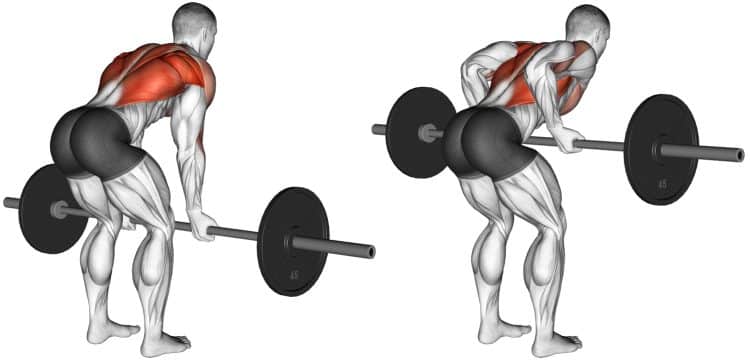A thick, muscular back is truly a sight to behold. It doesn’t matter how pumped your pecs or how capped your delts are; if your back is weak, your physique will always be missing something important.
When it comes to back training, many lifters mistakenly believe that the only thing they need is pull-ups and pulldowns. And while vertical pulls ARE good for building back width, they don’t usually do much for back thickness.
Bodybuilders have a saying: if you want to grow, you gotta row, and like so many sayings, this has a ring of truth about it.
So, if you want to build a back you can be truly proud of, you MUST include plenty of rowing exercises in your pull-day workouts.
In this article reveal why and how to perform reverse grip rows and the variations and alternatives you can do instead.
Muscles Worked in Reverse Grip Row
Reverse grip rows are a compound exercise. Compound exercises involve two or more joints and multiple muscles. The main muscles trained by reverse grip rows are:
Level Up Your Fitness: Join our 💪 strong community in Fitness Volt Newsletter. Get daily inspiration, expert-backed workouts, nutrition tips, the latest in strength sports, and the support you need to reach your goals. Subscribe for free!
Latissimus dorsi
Located on the sides of your upper back, the lats are the muscles that give you your V-taper and torso width. The functions of the lats are extension, adduction, and medial rotation of the shoulders. However, reverse grip rows are predominantly a shoulder extension exercise.
Trapezius and rhomboids
The trapezius is the large diamond-shaped muscle that lays across and between your shoulder blades. Three groups of fibers make up the trapezius – upper, middle, and lower.
All three sets of fibers are involved in reverse grip rows, but the middle fibers are the most active as they work to pull your shoulders back and together. The middle traps work with the rhomboids, which are small muscles located between the shoulder blades.
Deltoids
The deltoids are your shoulder muscles. Like the trapezius, the deltoids comprise three groups of fibers, which are called heads: anterior (front), medial (side), and posterior (rear). All three heads are involved in reverse grip rows, but the posterior head is most active as it plays a role in shoulder extension.
Biceps brachii
Known as the biceps for short, this muscle is located on the front of your upper arm and is responsible for the flexion of the elbow joint. The reverse or underhand grip puts the biceps in a very favorable position. As such, you may find you can lift heavier weights or do more reps than with overhand rows.
Forearms
Gripping and holding your barbell will challenge and develop your grip strength, building bigger, more powerful forearms in the process. Depending on your grip strength, you may benefit from using wrist straps for this exercise. Otherwise, your forearms may fail before back.
Core
It’s impossible to do reverse grip rows without using your core, which is the collective name for the muscles of your midsection. The core muscles include the erector spinae, rectus abdominis, obliques, transverse abdominis, and obliques.
These muscles act like a weightlifting belt to support your lumbar spine as you lean forward to perform your rows. Purposefully engaging your core, a maneuver called bracing, makes reverse grip rows a much safer exercise.
Gluteus maximus, hamstrings, and quadriceps
Reverse rows are undoubtedly an upper-back exercise, but you can’t do them without using your lower body. Bending forward and then maintaining that position as you pump out your reps involves your gluteus maximus, hamstrings, and quadriceps. So, you may feel your legs working even though you are training your back.
How to Do Reverse Grip Rows
Get more from reverse grip rows while keeping your risk of injury to a minimum by following these guidelines:
- Hold your barbell with a shoulder-width, underhand grip. Stand with your feet about shoulder-width apart. Bend your knees slightly, brace your core, and pull your shoulders down and back.
- Hinging from your hips, lean forward until your upper body is slightly above parallel to the floor.
- Let your arms hang straight down from your shoulders. Take care not to let your lower back become rounded. Tuck your chin in and look down at the floor just in front of your feet.
- Leading with your elbows, bend your arms and pull the bar up and into your abdomen. Keep your wrists straight.
- Extend your arms and repeat.
Pro Tips:
- Wear a weightlifting belt to support and protect your back during this exercise.
- Start with the barbell resting in a squat rack. This will save you from deadlifting the bar from the floor at the start of each set.
- Squeeze your shoulders down and back, and keep your elbows close to your sides to maximize back engagement.
- Experiment with a slightly wider or narrower grip to see which works best for you.
- Do NOT use your legs or lower back to help lift the weight, as doing so takes work away from the target muscles.
Reverse Grip Row Benefits
Not sure if reverse grip rows deserve a place in your workouts? Check out these benefits and then decide!
Lift more weight or do more reps
Most rowing exercises use an overhand grip. While there is nothing wrong with this, it does put your arms in a less biomechanically efficient position, which means your biceps may fail earlier.
Using an underhand grip puts your biceps into a somewhat stronger position, so they are less likely to fatigue prematurely. This should mean you can use heavier weights or do more reps with an underhand grip, leading to a more productive workout.
More lower-back friendly
Reverse grip bent over rows involve pulling the bar into your abdomen. This creates a relatively short lower back lever and less lower back stress. If overhand bent-over rows cause back pain, you may find the reverse grip variation more comfortable.
A great biceps exercise
Reverse grip rows are an excellent back exercise but could also be the key to building bigger biceps. The palms-up grip means your biceps are in a powerful position, and the movement is much like doing barbell curls.
So, whether you want to put more biceps into your back workout, or build your arms without having to do so many curls, reverse grip rows could help.
Drawbacks
While reverse grip rows are a mostly beneficial exercise, there are also a few drawbacks to consider:
Lower back stress
At the risk of being contradictory, while reverse grip rows ARE more spine-friendly than other rowing variations, they still put a fair amount of stress on your lower back. For this reason, many personal trainers avoid prescribing any bent-over row to their clients.
However, reverse grip rows are a reasonably safe exercise, providing you brace your core and avoid rounding your lower back. That said, back pain sufferers may still want to use an alternative.
Level Up Your Fitness: Join our 💪 strong community in Fitness Volt Newsletter. Get daily inspiration, expert-backed workouts, nutrition tips, the latest in strength sports, and the support you need to reach your goals. Subscribe for free!
Forearm/wrist stress
Some lifters may find that reverse grip rows place more stress on their forearms and wrists than conventional rows. They may even be uncomfortable, especially if you have tight biceps. If you feel this exercise more in your arms than your lats, you may be better off using a neutral or overhand grip.
7 Reverse Grip Row Variations and Alternatives
Reverse grip rows are a highly effective upper back exercise, but that doesn’t mean you need to do them all the time. There are several variations and alternatives you can use to keep your workouts productive and interesting:
1. Yates Row
The Yates row is named after legendary bodybuilder and six-times Mr. Olympia winner Dorian Yates. This was Yates’ preferred method of doing bent-over rows. He, too, used a reverse or underhand grip. However, he didn’t lean over as far, which could be more lower back-friendly.
Steps:
- Hold your barbell with an underhand shoulder-width grip.
- Pull your shoulders down and back, brace your core, and stand with your feet roughly hip-width apart. Bend your knees slightly.
- Without rounding your lower back, hinge forward from the hips. Lean forward until your torso is angled to around 45 degrees and the bar is just above knee height.
- Bend your arms and pull the bar up and into your lower abs, tucking your elbows in as you pull.
- Squeeze your shoulders back and together briefly and then lower the bar, maintaining your core tension and neutral spine.
- Repeat for the prescribed number of reps.
Muscles Targeted:
- Primary: Latissimus dorsi, trapezius, rhomboids, biceps.
- Secondary: Posterior deltoids, erector spinae, gluteus maximus, hamstrings, quadriceps.
Benefits:
- Less lower back stress than conventional bent-over rows.
- Train with heavier weights or do more reps.
- A tried and tested back builder.
Tips:
- Pause at the bottom of the rep to briefly stretch your lats and increase your range of motion.
- Wear lifting straps to reinforce your grip and prevent it from failing before your back.
- Imagine you are trying to squeeze oranges in your armpits and a pencil between your shoulder blades to maximize back engagement.
Related: Yates Row Exercise Guide
2. Underhand Grip Pendlay Row
Pendlay rows are named after powerlifting and weightlifting coach Glen Pendlay. Also known as dead-stop rows, each rep of Pendlay rows starts and ends with the weight resting on the floor. This helps eliminate unwanted momentum and provides your lower back and grip with a brief rest between reps so you can use more weight.
Steps:
- Place your barbell on the floor and stand behind it. Your toes should be under the bar.
- Reach down and hold the bar with a shoulder-width underhand grip. Straighten your arms, brace your core, and lift your hips, so your torso is parallel to the floor.
- Brace your core and pull your shoulders down and back.
- Without jerking with your legs or lower back, row the weight off the floor and into your abdomen.
- Lower the bar back to the floor, let it rest there for 1-3 seconds and then repeat.
Muscles Targeted:
- Primary: Latissimus dorsi, trapezius, rhomboids, biceps.
- Secondary: Posterior deltoids, erector spinae, gluteus maximus, hamstrings, quadriceps.
Benefits:
- An excellent exercise for building upper and lower back strength.
- Makes it much harder to cheat the weight up.
- More lower back-friendly than most conventional bent-over rows.
Tips:
- Raise the bar on blocks if you cannot lean forward without rounding your lower back.
- You can also do this exercise with an overhand grip or with dumbbells and a neutral grip.
- Relax and then reset your core and grip between reps to maximize performance.
3. Chest-Supported Reverse Grip Row
While reverse grip rows are more lower-back-friendly than regular bent-over rows, the lower back is still strongly involved. That all changes with chest-supported reverse grip rows. With this exercise, your upper body is fully supported, so your lower back is completely removed from the movement. This leaves you free to focus on pushing your upper back to its limit.
Steps:
- Set the backrest on an adjustable bench to around 30-45 degrees. Place your barbell on the floor beneath the backrest.
- Lie face down on the bench with your head uppermost. Reach down and hold the bar with an underhand, shoulder-width grip. Pull your shoulders down and back, and brace your abs.
- Leading with your elbows, bend your arms and pull the bar up to the underside of the bench.
- Extend your arms and repeat.
Muscles Targeted:
- Primary: Latissimus dorsi, trapezius, rhomboids, biceps.
- Secondary: Posterior deltoids.
Benefits:
- No lower back stress to worry about.
- Train to failure in complete safety.
- An excellent exercise for novices.
Tips:
- Focus on driving your elbows backward to maximize lat engagement. Imagine you are trying to elbow someone behind you in the nose!
- You can also do this exercise with an overhand grip or with dumbbells.
- Try using a flat bench for variety, which is an exercise called seal rows:
4. Reverse Grip Inverted Row
No weights? No problem! You can mirror the effects of reverse grip rows with just your body weight for resistance. This is an excellent exercise for calisthenic athletes and anyone who prefers bodyweight training over weight lifting.
Steps:
- Using a Smith machine or a barbell in a squat rack, set the bar to around waist height.
- Sit on the floor beneath the bar and grip it with an underhand, shoulder-width grip. Then, straighten your arms and pull your shoulders down and back.
- Lift your butt off the floor so that your legs and body form a straight line. Brace your abs.
- Bend your elbows and pull your body up to the bar, keeping your body tight and straight throughout.
- Extend your arms and repeat.
Muscles Targeted:
- Primary: Latissimus dorsi, trapezius, rhomboids, biceps.
- Secondary: Posterior deltoids, erector spinae, gluteus maximus, hamstrings, quadriceps.
Benefits:
- Very little lower back stress.
- An ideal exercise for beginners.
- Suitable for home exercisers.
Tips:
- Place your feet on a bench to make this exercise more challenging.
- Raise the bar to lessen the weight on your arms and make this movement easier.
- You can also do this exercise with an overhand grip.
5. Reverse Grip Cable Row
If lifting freeweights has a disadvantage, it’s that the load on your muscles changes as you perform your reps. In most cases, the weight peaks as you near the midpoint of each rep. Cable exercises are different and tend to offer a more even load distribution. This is not necessarily better, but some people prefer cable exercises over freeweights for this reason. The good news is that you can replicate the effect of reverse grip rows with a cable machine.
Steps:
- Attach a straight bar to a seated cable row machine. Sit on the seat and grab the handle with an underhand, shoulder-width grip.
- Place your feet on the footplates and sit up straight with your arms extended, core braced, and shoulders down and back. Your knees should be slightly bent but rigid.
- Leading with your elbows, bend your arms and pull the handle into your abdomen. Keep your wrists straight.
- Extend your arms and repeat.
Muscles Targeted:
- Primary: Latissimus dorsi, trapezius, rhomboids, biceps.
- Secondary: Posterior deltoids, erector spinae, gluteus maximus, hamstrings, quadriceps.
Benefits:
- Much more lower back-friendly than standing bent over rows.
- Cable exercises keep almost constant tension on the target muscles.
- You can do muscle-building drop sets with this exercise.
Tips:
- No cable machine? You can also do this exercise with a resistance band.
- Keep your chest up and shoulders back to maximize lat engagement.
- Experiment with wider and closer than shoulder-width grips to see which you feel more.
6. Reverse Grip Lat Pulldown
To build the ultimate back, you need a balance of vertical and horizontal pulling exercises. Like reverse grip rows, reverse grip pulldowns put your biceps in a stronger-than-usual position, so you should find you can lift more weight or do more reps than with the overhand version.
Steps:
- Attach a straight bar to a lat pulldown machine. Grip the bar with a shoulder-width underhand grip and then sit down on the seat. Anchor your legs and then lean back slightly. Pull your shoulders down and back, and brace your abs.
- Bend your arms and, leading with your elbows, pull the bar down to your upper chest.
- Extend your arms and repeat for the prescribed number of reps.
Muscles Targeted:
- Primary: Latissimus dorsi, trapezius, rhomboids, biceps.
- Secondary: Posterior deltoids.
Benefits:
- An excellent exercise for building a wider back.
- No lower back stress to worry about.
- A useful preparatory exercise for bodyweight chin-ups.
Tips:
- Imagine pulling your elbows down to your hips to maximize lat engagement.
- Lift your chest rather than lean back excessively to get the most from this exercise.
- Keep your torso stationary throughout. If you have to swing and sway to pull the weight down, it’s probably too heavy.
7. Chin-Ups
The mighty pull-up is arguably one of the best bodyweight exercises for your back and lats. However, chin-ups are a little easier, as they put your biceps in a more favorable position and work pretty much the same muscles. Feeling strong? Give weighted chin-ups a shot!
Steps:
- Hold a pull-up bar with an underhand grip, hands roughly shoulder-width apart.
- Hang from the bar with your arms straight, shoulders pulled down and back, and core braced.
- Let your legs hang down below you, crossing your ankles behind you if you wish.
- Without kicking or swinging, bend your arms and pull your chin up and over the bar.
- Lower yourself back down under control.
- Continue until you are unable to do another rep with perfect form.
Muscles Targeted:
- Primary: Latissimus dorsi, trapezius, rhomboids, biceps.
- Secondary: Posterior deltoids.
Benefits:
- An excellent back-builder for home exercisers.
- A good way to test and develop relative strength.
- A great incentive to lose weight – every pound dropped will make chin-ups feel easier!
Tips:
- Drive your elbows down and back to maximize lat engagement.
- Avoid kicking or swinging except when trying to complete your final rep.
- Use a resistance band for assistance if you cannot do chin-ups unaided.
Reverse Grip Row FAQs
Do you have a question about reverse grip rows or back training in general? We’ve got the answers you seek!
1. How many reps of reverse grip bent over rows should I do?
Not so long ago, the standard rep range recommendation for muscle growth was 6-12. However, more recently, it’s been revealed that anywhere from 6 to 35 reps can result in muscle growth, provided you take your sets close to failure (1).
This is excellent news for anyone who does bodyweight or resistance band training, where high reps are the norm. However, high reps are less useful for building strength, where heavy weights (85%+ of your one-repetition maximum) are best. For strength, sets of 1-5 are generally more effective.
2. Are reverse grip rows essential?
Reverse grip rows are one of several effective rowing exercises. As such, they’re good to do but not essential. So, if you don’t like them, you don’t have to do them if you don’t want to. So long as you include a couple of different rowing exercises in your back workout, you should get the results you want.
Related: 12 Best Rowing Exercises to Build Muscle Mass
3. Are reverse grip rows safe?
There is a risk of injury for all bent-over row exercises. Bending over with a weight in your hands puts a considerable stress on your lower back. This stress creates no problems for some, but it can be a source of pain and injury for others.
You can make reverse grip rows safer by doing them with a slightly arched and never rounded lower back. You must also brace your core and stop your sets before your form starts to break down. Wearing a weightlifting belt may also help.
However, suppose you have previously experienced back pain. In that case, you may want to avoid unsupported bent-over rows and stick to movements like seated cable rows and chest-supported rows, which are much more lower back-friendly.
4. Are reverse grip rows better than the overhand version?
Reverse and overhand grip rows are so similar that they are interchangeable. Both exercises work your major and minor back muscles. The only real difference is the amount of biceps engagement, with the reverse grip putting your biceps in a stronger position.
Try both variations and see which you prefer. However, one is not significantly better than the other.
5. Do I have to do rows to build a bigger back? Aren’t pull-ups and pulldowns enough?
There are a lot of muscles in your back, and many have two or more functions. For example, the lats are responsible for shoulder adduction and shoulder extension. Pulldown-type movements involve mostly shoulder adduction, while rowing movements involve more shoulder extension.
So, if you want to develop your back fully, you need to train it from multiple angles. In other words, for a back that’s thick AND wide, you need to include rows and pulldowns/pull-ups in your workouts.
Wrapping Up
Reverse grip rows can take some getting used to. The hand position just feels odd, especially if you are used to doing overhand or neutral grip rows. However, it’s this oddness that makes reverse grip rows so effective. Hitting your muscles from even a slightly different angle is often all that’s needed to keep you out of a training rut and maintain your progress.
So, add some variety to your back workouts with reverse grip rows. If nothing else, switching to an underhand grip will allow you to do more reps or lift a little more weight than usual.
References:
1- PubMed: Effects of resistance training performed to repetition failure or non-failure on muscular strength and hypertrophy: A systematic review and meta-analysis https://pubmed.ncbi.nlm.nih.gov/33497853/
Interested in measuring your progress? Check out our strength standards for Barbell Curl, Pendlay Row, Pull Ups, and more.









